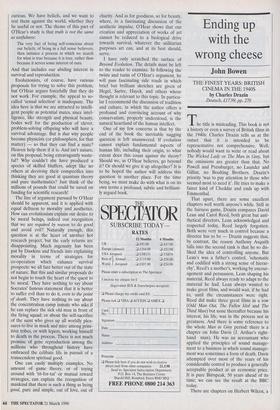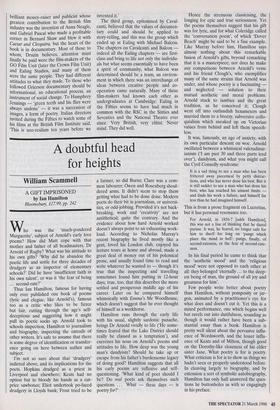Ending up with the wrong cheese
John Bowen
THE FINEST YEARS: BRITISH CINEMA IN THE 1940S by Charles Drazin Deutsch, £17.99, pp. 270 The title is misleading. This book is not a history or even a survey of British films in the 1940s: Charles Drazin tells us at the outset that it is intended to be representative not comprehensive. Well, nobody would want to write or read about The Wicked Lady or The Man in Grey, but the omissions are greater than that. No Powell and Pressburger, no Launder and Gilliat, no Boulting Brothers. Drazin's priority 'was to pay attention to those who seemed most to need it'. He tries to make a fairer kind of Cheddar and ends up with Emmenthal.
That apart, there are some excellent chapters well worth anyone's while. Still in the fairness game, Drazin compares David Lean and Carol Reed, both great but anti- thetical directors, Lean acknowledged and respected today, Reed largely forgotten. Both were very much in control because a director has to be — Drazin suggests that, by contrast, the reason Anthony Asquith falls into the second rank is that he so dis- liked the idea of controlling anyone. But Lean's was a father's control, 'schematic and codified with a strong sense of hierar- chy', Reed's a mother's, working by encour- agement and persuasion, Lean shaping his material, Reed always ready to adapt to the material he had. Lean always wanted to make great films, and would wait, if he had to, until the circumstances were right. Reed did make three great films in a row (Odd Man Out, The Fallen Idol and The Third Man) but none thereafter because his interest, his life, was in the process not in greatness. And there is some reference to the whole Man in Grey period: there is a chapter on John Davis (J. Arthur's right- hand man). He was an accountant who applied the principles of sound manage- ment to a business in which sound manage- ment was sometimes a form of death. Davis attempted over most of the years of his considerable control to produce a generally acceptable product at an economic price. It is pure Birtspeak, 50 years ahead of its time; we can see the result at the BBC today.
There are chapters on Herbert Wilcox, a brilliant money-raiser and publicist whose greatest contribution to the British film industry was the invention of Anna Neagle, and Gabriel Pascal who made a profitable corner in Bernard Shaw and blew it with Caesar and Cleopatra, but the heart of the book is in documentary. Most of those to whom, Drazin believes, attention must finally be paid were the film-makers of the GO Film Unit (later the Crown Film Unit) and Ealing Studios, and many of them were the same people. They had different attitudes to what they made. To those who followed Grierson documentary should be informational, an educational process, an instrument of social change. To Humphrey Jennings — 'green teeth and his flies were always undone' — it was a succession of images, a form of poetry. Italian directors invited during the Fifties to watch some of his films at the British Film Institute said, `This is neo-realism ten years before we invented it.'
The third group, epitomised by Caval- canti, believed that the values of documen- tary could and should be applied to story-telling, and this was the group which ended up at Ealing with Michael Balcon. The chapters on Cavalcanti and Balcon indeed all the Ealing chapters — are first- class and bring to life not only the individu- als but what seems essentially to have been a spirit of community, what Balcon was determined should be a team, an environ- ment in which there was an interchange of ideas between creative people and co- operation came naturally. Many of these film-makers had known each other as undergraduates at Cambridge: Ealing in the Fifties seems to have had much in common with the RSC in the Sixties and Seventies and the National Theatre ever since. Very British, very elitist. Never mind. They did well.





































































 Previous page
Previous page